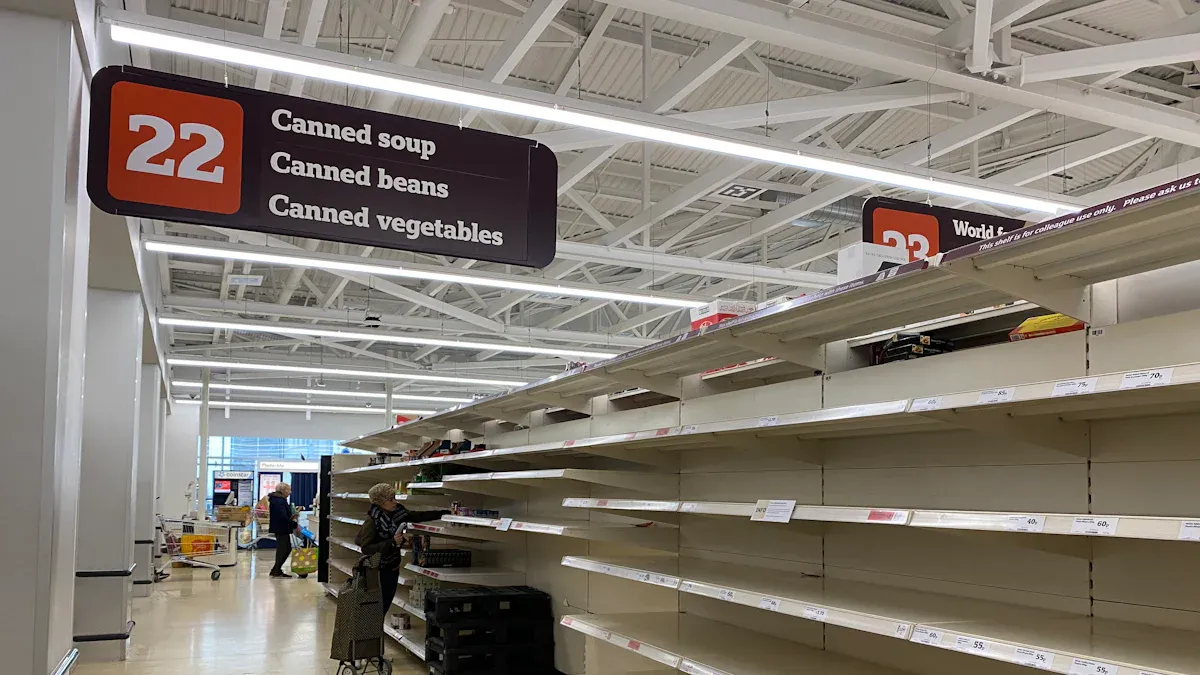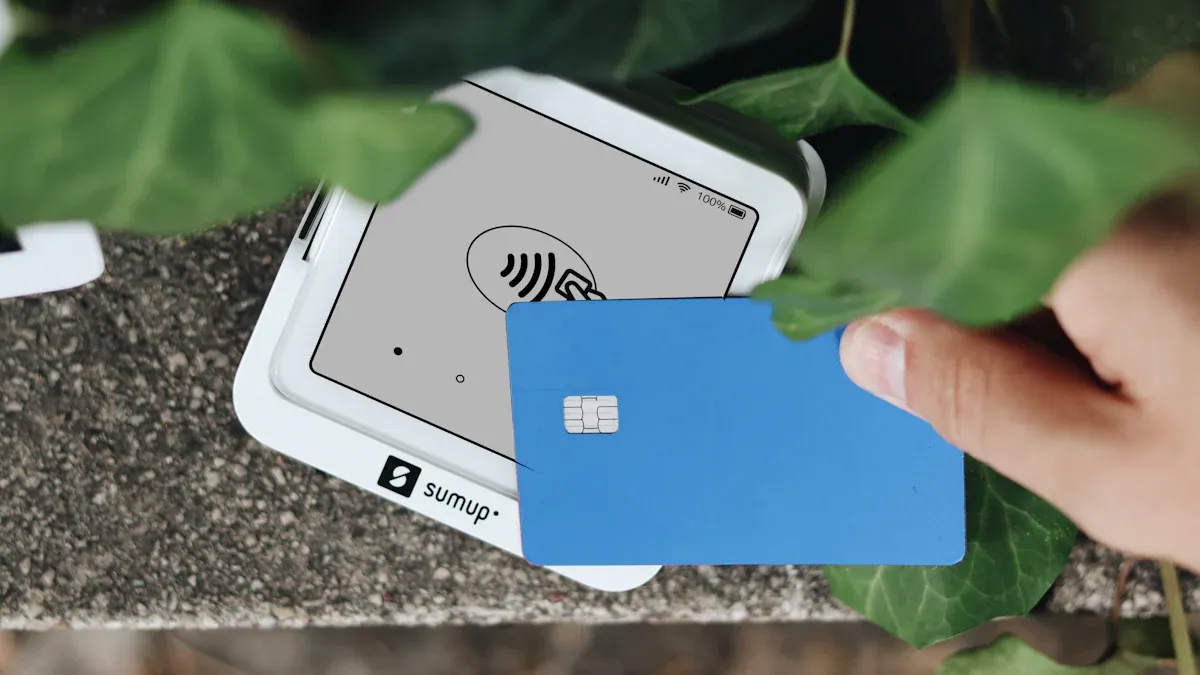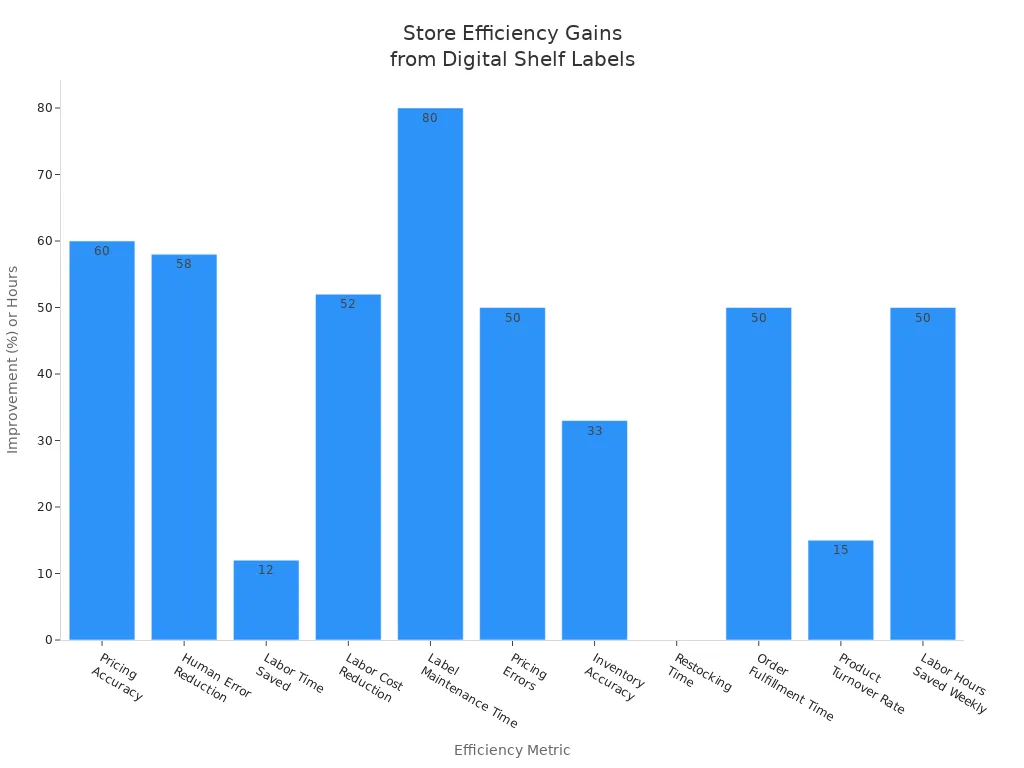
Digital shelf labels have transformed how stores manage pricing and efficiency. These systems enable real-time pricing accuracy, which eliminates manual errors and ensures consistency. Stores using Electronic Shelf Labels and solutions like ESL Gateway AP or ESL Price Tag see significant benefits. Labor costs can drop by up to 80%, with annual savings reaching over $10,000 for a mid-sized location. Esl Retail operations also benefit from reduced energy use and the elimination of recurring supply expenses. The benefits of digital shelf labels extend beyond cost, supporting a sustainable future for retail.
Understanding Electronic Shelf Labels and Their Benefits
How Digital Shelf Labels Work
Digital shelf labels use advanced technology to automate and streamline price management in retail stores. Each label contains a display panel, often using e-ink for clear visibility and low power consumption. Some models use LCD screens to support color and animation, though these require more energy. The power source typically consists of long-life lithium batteries, which can last several years. Wireless communication modules, such as RF, BLE, or Wi-Fi, enable real-time updates from a central system. Staff can update prices or promotions instantly through a software platform that connects to the store’s ERP or POS system.
Tip: Integration with inventory and POS systems allows digital shelf labels to display accurate pricing and stock information, reducing manual errors and improving operational efficiency.
The following table outlines the main technological components of electronic shelf labels:
| Component | Description & Function |
|---|---|
| Display Panel | E-ink or LCD; e-ink offers low power and high readability, LCD supports color/animation but uses more power. |
| Power Source | Long-life lithium batteries, sometimes rechargeable or solar-powered. |
| Communication Module | Wireless (RF, BLE, Wi-Fi) for real-time updates and synchronization. |
| Mounting Systems | Magnetic, clip-on, or adhesive mounts for secure shelf attachment. |
| Software Platform | Centralized management for bulk updates, dynamic pricing, and user-friendly interfaces. |
| Security Measures | Data encryption and restricted access to protect pricing data. |
Electronic Shelf Labels vs. Traditional Paper Tags
Digital shelf labels offer several advantages over traditional paper tags. Retailers can update prices across thousands of products in seconds, eliminating the need for manual changes. This automation reduces labor costs and minimizes pricing errors. Digital shelf labels also support dynamic pricing, allowing stores to respond quickly to market trends and competitor actions.
Key benefits include:
- Real-time price accuracy and consistency across all channels.
- Reduced operational costs by automating price updates.
- Enhanced customer experience with clear, up-to-date information.
- Improved inventory management through integration with POS systems.
- Environmental benefits by reducing paper waste.
Traditional paper tags require frequent printing and manual replacement, which increases labor and material costs. Digital shelf labels, in contrast, support sustainability goals and future-proof retail operations by leveraging technology for efficiency and accuracy.
Real-Time Price Accuracy: The Key Benefits of Digital Shelf Labels

Eliminating Manual Pricing Errors
Retailers often struggle with pricing errors when using traditional paper tags. Manual updates require staff to replace each label by hand, which leads to frequent mistakes and delays. Digital shelf labels solve this problem by automating price changes. These systems connect directly to ERP and POS platforms, allowing real-time price updates across the entire store. Staff no longer need to walk the aisles to change prices, which reduces human error and saves valuable time.
- Traditional paper labels require manual replacement, increasing the risk of outdated or incorrect pricing.
- Digital shelf labels enable centralized, real-time updates, minimizing the chance of mistakes.
- Automation reduces labor costs and ensures prices remain accurate, even during busy periods.
A recent study found that stores using digital shelf labels experienced a 90% reduction in pricing errors. This improvement not only saves time but also prevents costly checkout disputes.
Ensuring Consistent Pricing Across Channels
Maintaining accuracy and consistency in pricing across physical and online channels remains a challenge for many retailers. Digital shelf labels address this issue by synchronizing prices instantly through real-time updates. When a price changes online, the same adjustment appears on the shelf within seconds. This seamless integration helps retailers avoid customer confusion and ensures compliance with pricing regulations.
Note: Real-time price updates help retailers avoid government fines and customer complaints by keeping shelf prices accurate at all times.
Digital shelf labels also support dynamic promotions, allowing stores to respond quickly to market trends. This flexibility leads to enhanced accuracy and speed in price management.
Case Study: Preventing Price Discrepancies with Electronic Shelf Labels
According to the National Retail Federation, switching to electronic shelf labels led to a 30% decrease in pricing errors for many retailers. Centralized control and real-time updates eliminated the delays and inconsistencies common with manual methods. As a result, stores improved customer satisfaction and reduced operational risks. Digital shelf labels provide a reliable solution for retailers seeking to prevent price discrepancies and maintain trust with shoppers.
Operational Efficiency and Labor Savings with Electronic Shelf Labels
Streamlining Price Updates and Store Management
Digital shelf labels transform store management by automating price updates and reducing manual intervention. Staff no longer spend hours printing and replacing paper tags. Instead, electronic shelf labels connect wirelessly to a central system, enabling instant and consistent price changes across the entire store. This automation leads to significant cost savings and improved operational efficiency.
- Manual updates with paper tags are time-consuming and prone to errors.
- Digital shelf labels allow remote, real-time updates, eliminating the need for physical label changes.
- Staff can focus on higher-value tasks, such as merchandising and inventory management.
- Retailers can respond quickly to market changes, promotions, and inventory adjustments.
A comparison of maintenance costs highlights the advantages:
| Cost Aspect | Electronic Shelf Labels (ESL) | Traditional Paper Tags |
|---|---|---|
| Ongoing Maintenance | Battery replacement, technical support | Printing and physical replacement of tags |
| Labor & Time Costs | Low, updates done electronically | High, manual replacement is time-consuming |
| Durability & Lifespan | Longer lifespan, less frequent replacements | Fragile, frequent replacements |
“The biggest difference between electronic labels and paper labels are the cost reduction and efficiency increases. The old process of changing a price tag—from printing to physically replacing them—is no longer necessary, and the bigger the retail outlet the more time and money that is going to save.” — Sue Li, Field Application Engineer, Minew
Freeing Up Staff for Enhanced Customer Service
By automating price updates, digital shelf labels free staff from repetitive tasks. Employees can now dedicate more time to customer service and merchandising. This shift improves the overall shopping experience and allows stores to operate with fewer resources. In stores with frequent price changes, streamlined operations ensure that staff remain available for customer engagement rather than manual updates.
Retailers report that employees spend up to 80% less time updating price tags after adopting electronic shelf labels. This efficiency enables stores to manage labor shortages and maintain high service standards.
Example: Labor Cost Reduction Through Digital Shelf Labels
Recent case studies demonstrate the impact of digital shelf labels on reduced labor cost. Maurer’s Market completed 1,400 price changes in under 10 minutes, a task that previously took four days. The store avoided hiring a replacement pricing employee after retirement, resulting in substantial cost savings. Houchens Food Group also reported positive returns on investment, with half of the savings attributed to labor and paper cost reductions. These examples show how digital shelf labels drive streamlined operations and operational efficiency, allowing retailers to recover their investment within one to three years.
Enhancing Customer Experience: Benefits of Digital Shelf Labels
Clear, Up-to-Date Pricing for Shoppers
Digital shelf labels provide shoppers with accurate and current pricing at all times. Real-time updates ensure that prices on the shelf match those at checkout, reducing confusion and frustration. Shoppers value this transparency, which leads to a smoother and more reliable shopping experience. At Walmart, digital shelf labels have improved staff productivity by automating price updates and stock replenishment. Features like ‘Stock to Light’ and ‘Pick to Light’ help associates locate products quickly, allowing them to spend more time assisting customers. This operational efficiency meets customer expectations for service and availability, resulting in higher satisfaction scores.
Customers appreciate knowing that the price they see is the price they pay, which builds confidence in the store.
Interactive Features and Product Information
Digital shelf labels offer interactive features that enrich the shopping journey. Many labels display QR codes or support NFC, enabling shoppers to access detailed product information, reviews, and even videos with a quick scan. Retailers report several benefits from these features:
- Real-time updates and interactive elements attract customer attention.
- QR codes and touchscreens provide instant access to product details.
- Personalized recommendations and offers increase engagement.
- Integration with AI and data analytics enables tailored deals.
These interactive capabilities create enhanced customer engagement and a more immersive in-store experience. Retailers observe that shoppers spend more time exploring products and feel more confident in their purchase decisions.
Building Trust and Loyalty with Electronic Shelf Labels
Digital shelf labels help retailers build trust and foster loyalty among shoppers. Consistent and transparent pricing reduces confusion and supports a positive store image. Research shows that shoppers find electronic shelf labels easy to use and helpful for quickly identifying prices. While shelf labels alone may not significantly change purchase behavior, their combination with promotions or personalized offers can encourage healthier choices and increase perceived value. Operational benefits, such as faster price updates and automated inventory alerts, free staff to focus on customer service. These improvements collectively enhance the in-store experience and strengthen customer loyalty.
Dynamic Pricing and Retail Agility: The Benefits of Electronic Shelf Labels
Responding Instantly to Market Changes
Retailers face constant shifts in demand, competition, and inventory levels. Digital shelf labels remove the manual barriers that limit how often prices can change. With this technology, stores can implement dynamic pricing strategies that respond to real-time market signals. AI-powered price optimization tools analyze customer behavior and competitor pricing, allowing retailers to adjust prices quickly. This automation helps stores capture margin opportunities and adapt to consumer trends. As a result, retailers can see up to 33% higher profit potential. Digital shelf labels also provide up-to-date product information, empowering customers to make informed decisions.
Note: Pricing flexibility gives retailers a competitive edge by allowing them to react instantly to market fluctuations.
Running Flash Sales and Promotions with Digital Shelf Labels
Digital shelf labels enable instant price updates across thousands of products. Manual price changes require staff to print and replace each tag, which can take hours. In contrast, digital shelf labels complete the same task in seconds. This speed allows retailers to launch flash sales or promotions almost immediately. For example, updating 5,000 prices with digital shelf labels takes about 10 minutes, which is 70% faster than manual methods. Many large supermarket chains report up to 98% pricing accuracy during promotions. This efficiency reduces labor costs and eliminates errors, making it easier to manage high-volume sales events.
- Instant price changes for flash sales
- Reduced labor and operational costs
- Improved accuracy during promotions
Adapting to Seasonal and Local Trends
Seasonal events and local trends require frequent price adjustments. Digital shelf labels support real-time, automated, and centralized price updates. Retailers can program changes in advance or adjust instantly based on demand. This system allows multiple price adjustments per week or even daily, which is essential during holidays or back-to-school seasons. Automation ensures consistent pricing across all store locations and channels. Features like countdown pricing and flash deal management help create urgency and manage limited-time offers. Centralized control also locks prices to prevent tampering, maintaining accuracy and customer trust.
Sustainability and Environmental Impact: Benefits of Digital Shelf Labels

Reducing Paper and Printing Waste
Retailers generate significant paper waste by constantly printing and replacing traditional price tags. Digital shelf labels offer a sustainable solution by eliminating the need for disposable paper tags. Over time, this shift reduces landfill-bound waste and cuts down on the resources required for printing and distribution. Many stores also use dynamic markdowns to reduce food and product waste, as real-time updates help move inventory before expiration. Digital shelf labels require minimal maintenance, and remote updates further reduce operational resource consumption compared to manual methods.
Lowering Carbon Footprint with Electronic Shelf Labels
Switching from paper tags to electronic shelf labels leads to measurable reductions in carbon emissions. A white paper from the UBC Sustainability Scholars Program and Smart Label Solutions™ found that replacing 5,840 paper labels with a single electronic shelf label over eight years can save about 8.52 kilograms of CO2 equivalent emissions. When applied across the Canadian retail sector, this change could result in an annual reduction of approximately 0.235 megatons of CO2 equivalent emissions. E-paper technology in these labels supports energy efficiency by consuming power only during updates, and extended battery life minimizes electronic waste. These features make electronic shelf labels a more sustainable and energy-efficient choice than traditional LCD or LED displays.
Supporting Green Retail Initiatives
Retailers increasingly prioritize green initiatives, and digital shelf labels support these goals in several ways:
| Sustainability Aspect | How Digital Shelf Labels Support Green Retail Initiatives |
|---|---|
| Waste Reduction | Replace disposable paper tags, reduce landfill waste, and enable dynamic markdowns to minimize product waste. |
| Energy Efficiency | Use e-ink technology and rechargeable batteries, consuming minimal power and supporting energy efficiency. |
| Carbon Emission Reduction | Automate real-time price updates, eliminating printing and logistics emissions. |
| Supply Chain Sustainability | Optimize inventory management, reduce packaging, and support recycling efforts. |
| Consumer Education & Engagement | Display eco-certifications and sustainability info, empowering shoppers to make informed choices. |
| Partnerships & Transparency | Collaborate with organizations to provide transparent sustainability metrics at the shelf edge. |
Digital shelf labels are designed for repair, refurbishment, and recycling, which further reduces electronic waste. Packaging improvements have saved over 212,000 kg of cardboard annually. These efforts align with global sustainability standards and help retailers transform physical stores into digital assets that promote responsible consumption.
Implementation and ROI: Maximizing the Benefits of Digital Shelf Labels
Upfront Investment vs. Long-Term Savings
Retailers often weigh the initial investment in electronic shelf labels against the long-term operational benefits. The upfront costs include hardware, integration, and installation. However, these expenses are offset by significant labor savings, improved pricing accuracy, and the elimination of recurring material costs. Most stores achieve a return on investment within 12 to 36 months. Some retailers reach this milestone in as little as 12 months, especially when combining digital shelf labels with price optimization software. Financing options, leasing, and pilot programs help manage the initial outlay, making the transition more accessible. Over time, stores benefit from reduced manual labor, fewer pricing errors, and enhanced sustainability, all of which contribute to increased profitability.
Monitoring key performance indicators such as update response time, price accuracy, and labor efficiency ensures that stores maximize their investment.
Scalability for Different Store Sizes and Types
Electronic shelf labels adapt well to a variety of retail environments. Small boutiques benefit from compact, wireless solutions that are easy to install and maintain. These stores often deploy labels selectively on high-impact items, using simple management platforms and customizable templates to support their brand identity. Large supermarkets require scalable systems capable of managing thousands of labels. These environments rely on robust wireless infrastructure, centralized management tools, and integration with inventory and POS systems for real-time updates and dynamic pricing.
| Store Size | ESL Characteristics and Needs | Management and Integration | Additional Notes |
|---|---|---|---|
| Small Boutiques | Compact, wireless ESLs; easy installation and maintenance; selective deployment on key items | Simple management platforms; customizable templates | Supports brand identity; frequent product updates |
| Large Supermarkets | Scalable systems managing thousands of labels; robust wireless infrastructure; long battery life | Centralized management tools; integration with inventory and POS systems | Real-time updates; dynamic pricing; high durability |
Suitability of Electronic Shelf Labels for Various Retail Environments
Retail environments present unique challenges during implementation. Budget constraints, system integration, and installation complexity often top the list. Flexible pricing models, phased rollouts, and pilot programs help retailers address budget concerns. Modern ESL platforms offer robust APIs and vendor support, ensuring compatibility with leading POS and ERP systems. Plug-and-play designs allow for quick installation, often completed overnight or during off-peak hours. Staff training remains straightforward, with intuitive interfaces and mobile apps reducing the learning curve. Retailers should also consider visual appeal, customer readability, and security standards to ensure a seamless fit across diverse retail environments. These strategies enable both small and large retailers to realize the full benefits of electronic shelf labels.
Digital shelf labels deliver measurable gains for retailers. Stores report up to a 60% increase in pricing accuracy, a 52% reduction in labor costs, and improved inventory accuracy from 65% to over 98%.
| Efficiency Metric | Improvement/Impact |
|---|---|
| Pricing Accuracy | Up to 60% increase |
| Labor Cost Reduction | 52% reduction |
| Inventory Accuracy | Improved from 65% to over 98% |

Electronic shelf labels also support sustainability by reducing paper waste and energy use. With rapid market growth projected, now is the ideal time for retailers to embrace this technology and future-proof their operations.
FAQ
What is a digital shelf label?
A digital shelf label is an electronic device that displays product pricing and information on retail shelves. Retailers update these labels remotely using a central system.
How long do electronic shelf label batteries last?
Most electronic shelf labels use lithium batteries. These batteries typically last three to five years before replacement becomes necessary.
Can stores integrate digital shelf labels with existing POS systems?
Retailers can integrate digital shelf labels with most modern POS and ERP systems. This integration enables real-time price updates and inventory management.
Are digital shelf labels difficult to install?
Most digital shelf labels feature wireless connectivity and simple mounting systems. Staff can install them quickly without specialized tools or extensive training.
Do digital shelf labels support promotions and flash sales?
Digital shelf labels allow instant price changes for promotions and flash sales. Retailers can schedule updates or adjust prices in real time to match marketing strategies.


